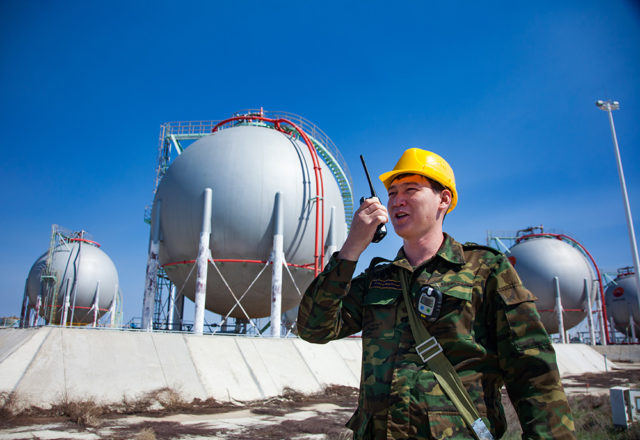
Beijing Expanding Size and Role of Its ‘Private’ Military Companies in Central Asia
Publication: Eurasia Daily Monitor Volume: 18 Issue: 115
By:

For the last several years, China has made use of its own private military companies (PMC) to guard Chinese industrial sites and transportation networks across Central Asia that it views as essential to its broader “One Belt, One Road” (more recently known as the Belt and Road Initiative—BRI) project. But now, in the wake of the withdrawal of the United States’ forces from Afghanistan, the rising strength of the Taliban and the militant group’s growing threats to Central Asian countries (see EDM, July 13), Beijing is expanding the presence and mission of these PMC troops. Chinese Foreign Minister Wang Yi, during a recent swing through Central Asia, told regional leaders that Beijing’s reliance on imported PMCs to guard local strategic infrastructure will be an important new form of security assistance to them against any threat from the outside (Eurasia Today, July 16). This expanded Chinese activity inevitably challenges other players in the region, including the Russian Federation, Turkey and the United States.
Like Russia and the US, China has developed so-called private military companies, groups that operate in the gray area between formal military establishments and private enterprise (particularly if the local law governing them is hazy). Crucially, PMCs can undertake a form of covert operations by giving the governments that use them the flexibility and deniability that the use of regular troops does not always offer. In contrast to other countries, China’s employment of PMCs has, in most cases, focused on the defense of Chinese economic and infrastructure sites in foreign countries, where these companies in effect serve as armed guards. Both because of that and because the Chinese have been reluctant to speak about what else they may be doing, information about such “private” Chinese military companies is relatively scarce (see China Brief, May 15, 2020; Topwar.ru, February 7, 2019; Current Time, February 2, 2019; RIA Novosti, March 23, 2017; Stan Radar, December 5, 2019).
That has been especially true in Central Asia, where the Chinese PMCs involved have not been especially numerous or gone beyond the functions of facility guards, until recently. One measure of how little coverage these Chinese units have received in Central Asia is that, earlier this year, a Kyrgyzstani news agency used a Jamestown EDM report as its basic source about what is going on (K-News, March 28—drawing on EDM, March 25). In large part, that reality reflects what had heretofore been the basic division of labor between China and the Russian Federation in the region: Beijing focuses on economic development, and Russia provides security. However, the situation in Afghanistan, Turkey’s effort to expand its influence in Central Asia (see EDM, February 18, April 1), and Russia’s inability to provide the kind of security it offered earlier have combined to prompt China to change its approach and to give its PMCs an expanded role in terms of their size and importance.
Beijing’s shift was signaled during the visit to Central Asian capitals earlier this month by Chinese Foreign Minister Wang, who stressed in each case China’s desire to provide the region with both “traditional” and “nontraditional” forms of security assistance. The latter, apparently, is to consist of inserting greater numbers of PMCs not just to guard local Chinese facilities but also to provide training and even leadership to the militaries of the Central Asian states. Until now, Russia had guarded the latter role—hard military cooperation—for itself, especially given its concerns about Turkish expansion (Eurasia Today, July 16). But increasingly both Russia and China are worried about the possibility of a Taliban incursion into Central Asia, with Beijing rating that possibility “extremely high,” Russian experts say (Nezavisimaya Gazeta, July 14). And so the two countries are taking steps to beef up their regional security assistance—Russia via the conduct of joint military maneuvers with Uzbekistan now taking place, and China with the dispatch of more private military company personnel. At present, these efforts are complementary; but there is the risk that with the rising Chinese presence, they will become competitive (see EDM, March 25).
Back in the spring, before the Taliban advance, for example, Stanislav Pritchin, a senior researcher at the Moscow Center for Post-Soviet Research at the Russian Academy of Sciences, said that the Kremlin hopes China will not dispatch its own PMCs into the region or expand their role beyond that of guards at Chinese facilities (Ia-centr.ru, March 15). At that time, Pritchin suggested Moscow is particularly concerned about such a Chinese presence in Kyrgyzstan and Tajikistan, two weak states where even a small presence of such paramilitary forces could play an outsized role in the domestic and foreign policies of the local governments.
So far, China has been remarkably cautious about dispatching private military companies to the region, the Moscow analyst noted. Their personnel in the region presently number only in the hundreds. And Beijing did not, he pointed out, send them to Turkmenistan in 2015–2016, when Ashgabat faced difficulties with Afghan militants on the border. At least in part, Pritchin continued, Beijing may have adopted this posture because of the rising tide of anti-Chinese attitudes in many parts of Central Asia, including most prominently Kyrgyzstan (Ia-centr.ru, March 15).
Nonetheless, the resurgence of the Taliban in Afghanistan and the danger that it will seek to expand its influence into Central Asia—either by direct incursions or as a role model for local radicals—has refocused China’s attention and changed its calculations as well as those of the Central Asian governments. The latter may have concluded that in the face of the growing Taliban threat, they have no choice but to turn to China; while Beijing appears to have decided to exploit this in the first instance by using its private military companies as its preferred method of operation.



